How to Get Motivated After 40: Ultimate Guide
Ever wondered why some folks above 40 seem to be brimming with energy and motivation? In contrast, others find it challenging to stay on track. It’s not just about willpower or determination; science also has much to do with it. In our previous post, we began exploring the fascinating world of motivation. Now, we’re diving further into how our brains work to help us get motivated after 40.
Welcome to a crash course on motivation after 40! We’ll unlock the secrets behind the incredible ‘get-up-and-go’ chemical our brains produce – dopamine, discover how setting the right goals can drive us forward, and learn about a host of feel-good hormones our bodies naturally produce.
Lastly, we’ll delve into the practical art of setting goals. Buckle up because understanding these factors can be a real game-changer in how we approach motivation in our life’s next chapter.
The Connection Between Dopamine and Motivation
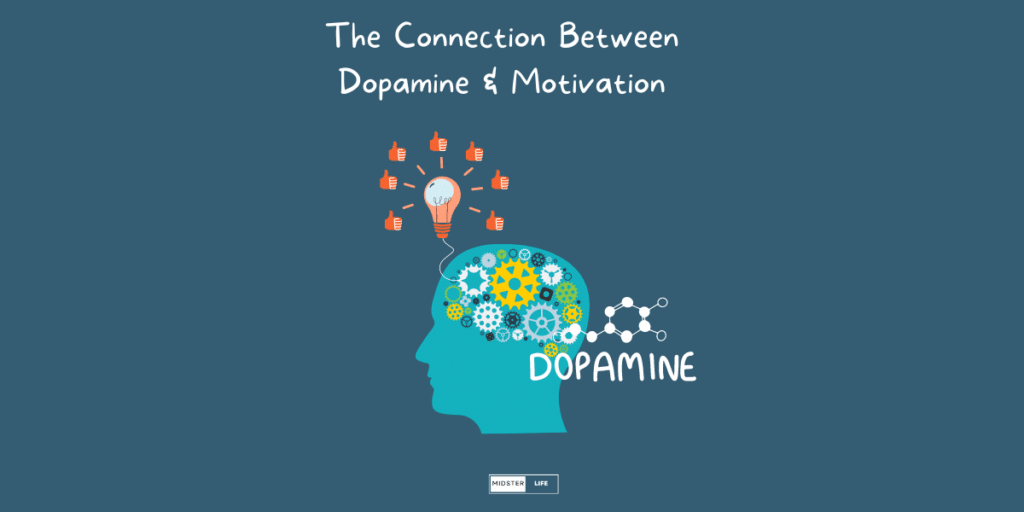
Our article on productivity and creativity unveiled the hidden star of productivity – dopamine. But, you may wonder, what exactly is this powerhouse molecule?
Imagine dopamine as the cheerleader in your brain. It’s a very important brain chemical that helps us chase our goals. Dopamine gives us energy and the push to get things done. Plus, it helps make adrenaline, giving us the rush to finish tasks and reach our goals. Dopamine is like the hidden helper in our brains that makes things happen!
Let’s dive further into how dopamine works, along with other essential hormones.
Feel-Good Hormones: The Magic Sauce of Motivation
Our mood, well-being, and motivation largely depend on feel-good hormones like dopamine, serotonin, endorphins, and oxytocin.
Each of them plays a starring role in shaping our mood, boosting our well-being, and powering our motivation. They are like magic sauces, sprinkling joy, excitement, and contentment into our lives. Getting to know them and how they work is like unlocking a secret toolkit for enhancing our daily life.
Dopamine: The Reward and Anticipation Hormone
As we’ve touched on, dopamine is associated with feelings of reward, hope, and anticipation. This hormone motivates us to engage in activities we like and are good at, creating a self-reinforcing cycle of pleasure and achievement.
But there’s more to dopamine than just being a motivator. It’s like a sweet treat your brain rewards itself with when you do something great. Feeling good after a hearty laugh or relishing a delicious meal? That’s dopamine spreading joy in your brain!
However, dopamine needs a bit of a nudge to work its magic. Firstly, it needs a genuine desire for a goal that you’re excited about. Secondly, a belief that the goal is within your reach. If either of these factors is missing, it’s like trying to start a car with an empty gas tank.
So, how can we ensure a steady flow of dopamine?
💪 Set exciting goals that inspire you.
🌞 Get exposure to natural sunlight for a mood boost.
💤 Prioritize quality sleep to recharge your brain.
🍽️ Fuel your body with a balanced diet.
Watch out for signs of a dopamine dip, like reduced motivation, difficulty focusing, and cravings for sweets. But remember, a well-balanced dopamine level is key to keeping your motivation high and making your daily life more enjoyable.
Harnessing the Power of Feel-Good Hormones
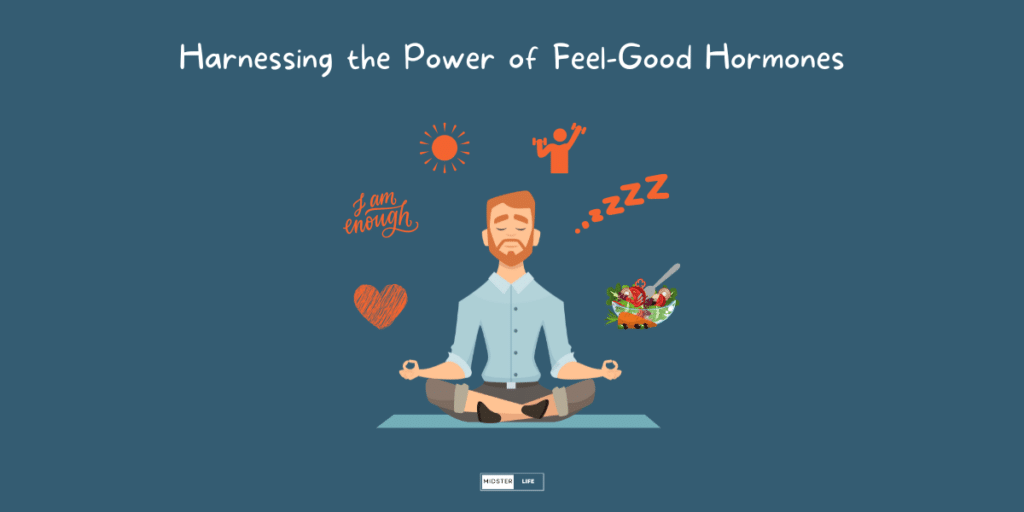
Serotonin: The ‘Happy Chemical’
Serotonin regulates mood, combating conditions like depression and anxiety, hence its nickname, the ‘Happy Chemical.’ You can increase serotonin levels through:
🏋️♀️ Engaging in regular exercise to enhance serotonin production.
😴 Prioritizing quality sleep for optimal serotonin balance.
🥦 Incorporating complex carbohydrates into your diet.
☀️ Getting outside and soaking up natural sunlight.
Practicing mind exercises such as positive affirmations, positive daydreaming, and self-talk can also boost serotonin. If you notice any of the following symptoms: moodiness, anxiety, aggression, and low self-esteem, then you may have a serotonin deficiency.
Endorphins: The ‘Natural High’ Hormone
Endorphins, often associated with a natural ‘high,’ are released to counteract pain, usually after physical exercise. This hormone can enhance self-esteem, mood, reduce stress, anxiety, and depression, and even aid sleep.
Boost endorphin levels:
🏋️♀️ Engage in physical exercise or activities you enjoy.
😂 Laugh out loud and enjoy moments of humor.
🧘♀️ Practice stress-reducing techniques like meditation or yoga.
💤 Prioritize quality sleep to aid endorphin release.
Oxytocin: The ‘Love and Bonding’ Hormone
Oxytocin, known as the ‘love and bonding’ hormone, builds during intimacy and closeness. This hormone can aid in alleviating symptoms of depression and anxiety.
Boost oxytocin levels:
💑 Foster deep connections with loved ones and spend quality time together.
🌼 Engage in acts of kindness and generosity.
📚 Read books or watch movies that evoke positive emotions.
🐶 Spend time with animals!
It’s essential to understand that the key to these hormones’ benefits lies in balancing them. Knowing how they work and how to boost them naturally can provide valuable tools for improving motivation, mood, and overall well-being.
Goal Setting for Motivation
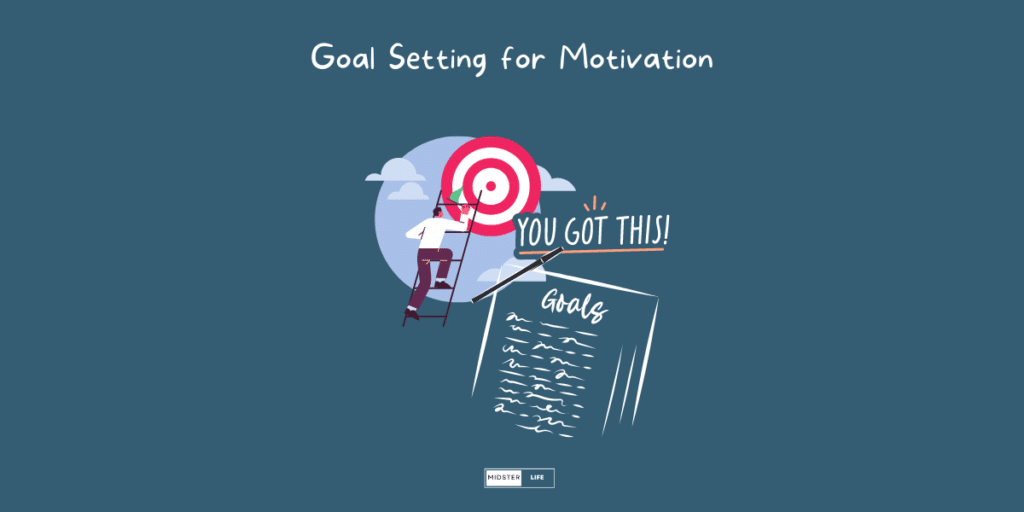
Setting clear, easy-to-measure, and realistic goals is a great way to keep up your motivation. This means turning broad desires into solid goals, which can help improve your motivation and chances of success. So, instead of saying, “I want to save money,” try saying, “I want to save $1000 in the next six months.” Making your goal specific like this makes it more reachable!
Goals Should Have Step-by-Step Instructions
Therefore each goal should include an action plan with step-by-step instructions detailing how you will achieve it. These instructions provide a clear path to follow, significantly enhancing your motivation and likelihood of success.
For Example:
- Identify the overall goal: “I want to become a more confident public speaker within six months.”
- Break down the goal into actionable steps:
- Research and identify relevant online courses or local workshops on public speaking.
- Enroll in a course or workshop and set a schedule for completing it.
- Set aside specific times each week for practicing learned techniques.
- Seek public speaking opportunities like local clubs, community events, or workplace presentations.
- Get feedback from trusted friends or mentors on your progress.
- Continually refine your skills based on feedback and self-reflection.
- At six months, evaluate your progress and adjust the plan if needed.
With this step-by-step plan, you have a clear path toward your goal. Each completed step brings a sense of accomplishment, spurring your motivation and bringing you one step closer to becoming a more confident public speaker.
Balancing Your Goals
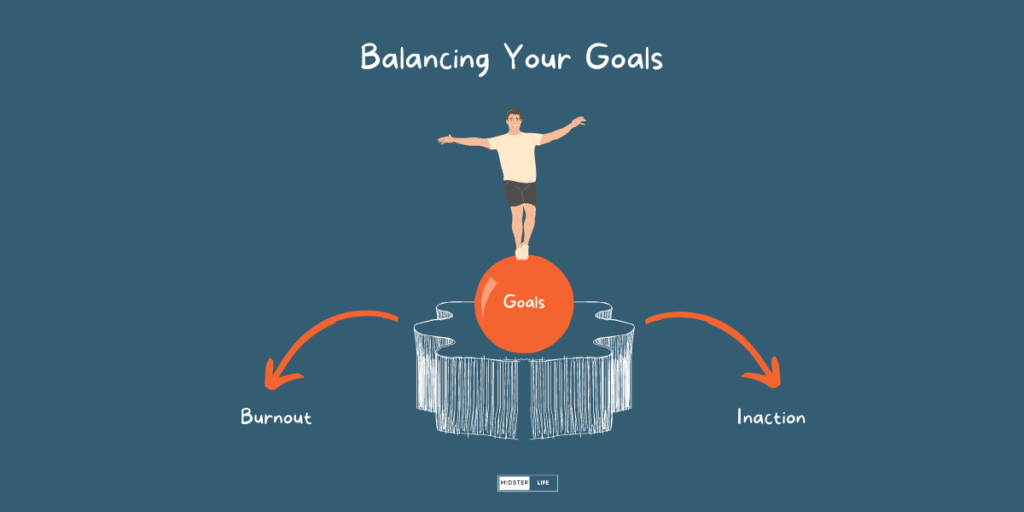
Maintaining a balance among various goals is crucial to avoid burnout and ensure sustained motivation. Here are some tips to help you achieve this balance:
- Schedule time to work on each goal: By dedicating specific time slots to each goal, you can ensure you give each area the attention it needs.
- Identify less important goals to eliminate: Not all goals are created equal. Identifying and eliminating less important goals can free up more time and energy to focus on your top priorities.
- Make weekly adjustments: Your situation and needs can change over time, so it’s essential to regularly review and adjust your goals to keep them aligned with your overall objectives.
Life is full of ups and downs, and there will undoubtedly be times when things don’t go according to plan. Some weeks, you may need to focus more on work at the expense of personal relationships, while other weeks, the reverse may be true. By regularly reviewing and adjusting your goals, you can ensure that they continue to serve you effectively, helping you maintain balance in all areas of your life.
If you find that your goals aren’t working for you, there are a few things you can do to improve the situation:
- Decrease the number of goals: If you’re feeling overwhelmed, it might be beneficial to focus on fewer goals.
- Extend deadlines: If your timelines are causing unnecessary stress, consider extending your deadlines to make your goals more achievable.
- Seek help: Don’t hesitate to ask for help if you struggle to achieve your goals. This can come from a coach, a trusted friend, or a mentor.
- Automate: Where possible, look for ways to automate tasks associated with your goals. This can save time and reduce the mental load, helping you stay motivated.
Remember, the ultimate purpose of setting goals is to improve your life, not to add unnecessary stress or pressure. By setting specific, measurable, and attainable goals and regularly reviewing and adjusting them, you can enhance your motivation and set yourself up for success.
Understanding the Dopamine Reward Prediction Error
Keeping up motivation has much to do with something called “Reward Prediction Error.” This has to do with how dopamine, a brain chemical, gets released and affects how good we feel when we achieve our goals.
To put it simply, when we reach a goal, we knew we could; we get a small happiness boost from a little extra dopamine. But if we achieve something we didn’t think we could, our brains release a lot more dopamine, making us feel super happy and driven.
However, if we don’t reach a goal or don’t get the success we expected, our dopamine levels drop, and we can feel less motivated. So, the trick is to set our goals in a way that keeps our dopamine flowing and our motivation high!
Breaking Down Bigger Goals
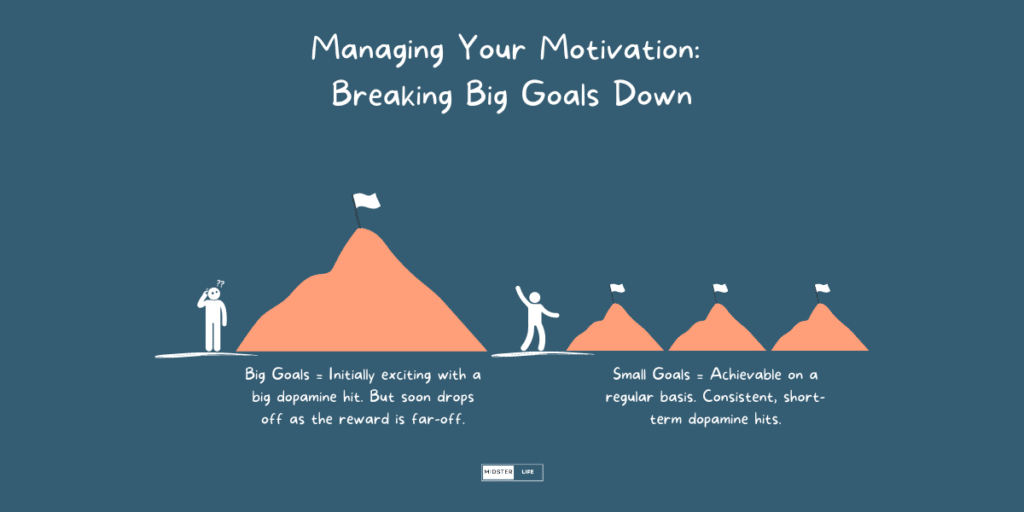
One way to keep your motivation steady is by breaking your big dreams into smaller, more manageable goals. By doing this, you help your brain give you regular happiness boosts, which keep you motivated.
These smaller, short-term goals are important because they’re things you can achieve on a regular basis. Each success gives you a happy kick from dopamine and keeps you focused on your bigger dream.
When you set your goals, try to do them in a way that makes them achievable and reduces the chances of failing. It’s okay to have a few hiccups along the way – they can help you learn. But remember, too many failures can bring down your dopamine levels and your motivation.
With a good plan that keeps your dopamine levels up, you’re more likely to stay motivated and reach your big dreams in the long run!
Journey and Destination: Striking the Balance
Goal setting is like cooking. You’ve got your big meal (the long-term goal) you’re aiming to prepare, like starting your own business. It’s exciting to think about, but it’s not going to happen without some prep work. That’s where the smaller, bite-sized tasks come in. These are the daily ingredients that go into making that big meal.
Completing these tasks is like chopping vegetables, marinating meat, or boiling pasta. They may seem small, but each one is an achievement. And each achievement gives your brain a happy boost, making you feel good and keeping you motivated to cook the whole meal.
The beauty of this process is that you’re not just aiming for that final dish. You’re learning and enjoying the process of cooking, which can be more fulfilling than eating the meal itself.
Think about it like you’re hosting a dinner party. Sure, you want to serve an amazing meal, but isn’t the process of preparing, the laughter, the aroma of food cooking, and the taste tests – all parts of the experience that make it truly enjoyable? And each of these moments gives you a little happiness boost, making you more likely to host dinner parties again. You enjoy the journey just as much, if not more, than the destination.
Getting a grip on how dopamine, goal-setting, and our feel-good hormones interact gives us a strong foundation to stay motivated, especially after we turn 40. With this knowledge in our toolkit, we can skillfully tackle any goal, big or small, and keep our motivation high.
What’s more, finding joy in the journey – not just reaching the finish line – makes the whole process more fun and fulfilling, adding to our drive. Whether we’re chasing a personal dream or a business goal, the secret is to tap into our body’s natural chemistry, make clear, doable goals, and love every step we take.
In the end, this deeper dive into motivation sets us up for reaching our dreams and improving our lives. It helps us stay excited, focused, and fully involved in life’s journey, keeping our zest alive beyond 40.


